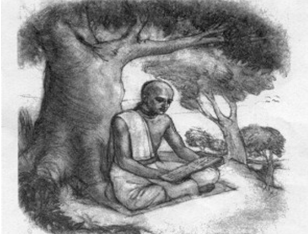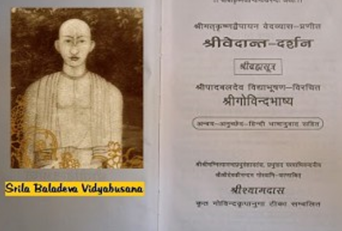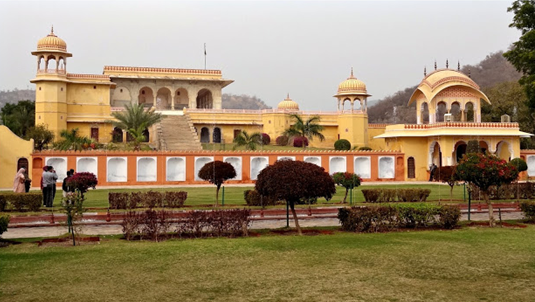
Galta is on the east outskirts of Jaipur. Up over the hill and down other side to the east you will find a very simple temple to Galtaji, the main temple of Galta. The sage Galav had kicked his foot into the side of the hill after calling the Ganga to appear there when the people complained that previous water had become salty. Further down the hill there is a temple dedicated to Surya, the sun-god, and natural springs said to possess curative properties. There are about 30 shalagram-shilas here. You can get a good view of the city in the valley below from the temple. There are 3 main kundas in this shrine of which, the Galta kund is considered the most sacred. Fed by a spring originating from a rock curve named Gaumukh, the Galta kund never runs out of water. You can take a taxi (15km) to here; it is a 2km walk from Surajpol gate.
Kanak Vrindavan
Kanak Vrindavan is situated in the bottom of Nahargarh hills adjoining the Amber Fort, on Jaipur-Amber Road. According to past records, the beautiful green valley was labeled as Kanak Vrindavan Valley by Maharaja Sawai Jai Singh, almost 280 years ago. The valley seemed like Vrindavan (Land of Lord Krishna) to the King, consequently he installed deity of Shri Govind Dev in the complex. The temples are closed from 1 to 4 pm. This place is on the way to the Amber fort on Amber Road, about 5km from downtown. To get here, you pass a large building in the middle of the lake and about 1km later you will see a sign for “Kanak Vrindavan and Govindaji ” on your right. There are two temples here. In the Radha Madhava temple, to your right as you drive in, are Jayadeva Goswami’s original Deities. They were brought to Jaipur in 1560, almost 450 years ago. There is a 1.3 m (4 ft) tall, black marble Krishna and brass Radharani, as well as a small set of Radha Krishna Deities here.
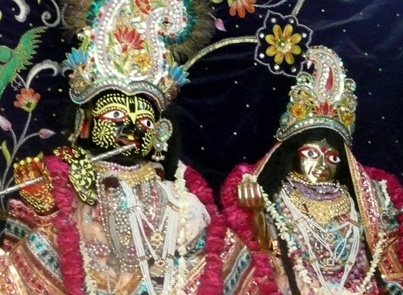
In the 18th centuried Natwarji Temple are the Deities of Amarkuar, Jaya Singh’s sister. There is beautiful silver work (known as meena work, done with mirrors and colored glass based in silver or white metal) around the altar. Kanak Vrindavan Valley is an exotic place in the desert lands of Jaipur, Rajasthan.
Story of Govinda Bhashya
In Jaipur, about 6 generations previous to the time when Govindajidev appeared, there was devotee named Payahari. Payahari was a grand disciple of Ramananda. Ramananda was a great acarya from the Ramanuja sampradaya who established the teachings of Ramanujacarya in northern part of India. And even today in northern India, there are millions of followers of Ramananda, they are called as Ramanandis. Generally, their ista dev, their worshippable deities are Sita and Rama. So he was living in a cave, in a place not far from Jaipur, in a valley called Galta and he was performing his devotional service there. The wife of the king became his disciple and of course she influenced her husband and soon the Ramanandi sampradaya of vaisnavism became the prominent spiritual path in that entire kingdom and this went on for about 6 generations.
The Ramanandi pandits, scholars and priests were in the highest position of giving spiritual direction and guidance to the king and all the people. At the time of Raj Jai Singh, whom Jaipur was named after, Govindaji, the king personally brought Govindaji to Jaipur. And along with Govindaji, pujaris and devotees who were Gaudiya vaisnavas in the line of Sri Rupa Goswami. And the king was so attracted to their worship; he considered it’s the ultimate perfection of his spiritual life that he brought Govindaji to Jaipur.
The Ramanandi scholars and pandits, they were becoming very much insecure because they were losing their superior position because the king was becoming a Gaudiya vaisnava and worshiping Govindaji. So they began to criticize Gaudiya vaisnavism and they actually went right to the king to lodge their complaints. They said that this Radha Govindaji, Radharani was sent by the son of maharaj Prataparudra, Purushottam Jana, he personally sent him to Jaipur to install beside Govindaji. So the Ramanandis were claiming 2 defects with Gaudiya sampradaya, therefore they must be rejected. One is that according to Padma Purana, there are 4 bonafide vaisnava sampradayas and there is no mention of this Gaudiya sampradaya, so they are bogus. And two is, you cannot worship Radharani with Krsna because they are not married. Lakshmi Narayan are legally married, Sita Rama are legally married, Radha and Krsna are not legally married, so it’s immoral to worship Radha and Krsna together on the altar. So Radharani must be removed and they put so much pressure with so many philosophical arguments, the king Jai Singh couldn’t ignore the brahmans. At that time there were 4 principle Gaudiya vaisnava temples in Jaipur, there was Radha Govindaji, Radha Vinoda, Radha Damodar and Radha Gopinath, all original dieties of Goswamis of Vrindavan who had taken shelter there. So he was consulting with these other Gaudiya vaisnava acaryas and there were some that are learned and they had their arguments and they had their reasoning but they couldn’t stand up before these pandits of Ramananda sampradaya.
So ultimately, Jai Singh was forced by these pandits to take Radharani away from Govindaji and have Her worshipped in a separate place. This broke the hearts of Gaudiya vaisnavas. Intolerable, but at the same time they were not able to defend themselves, so the devotees of Jaipur approached Viswanath Chakravarti Thakur and told them of their anguish and how the very authority of our entire sampradaya is being attacked. So Viswanath Chakravarti Thakur, he was eager to go there right himself and establish the pure authority of Caitanya Mahaprabhu’s siddhanta. But he was very old at that time. So he called upon his young siksha disciple, Baladev Vidyabhushan, he said “you must refute the controversial attacks of the Ramanandis and establish the purity of Radha and Krsna worship and the authority of the Gaudiya sampradaya.”

Viswanath Chakravarthy Thakur and Baladev Vidyabhushan and as well as one other devotee, disciple of Viswanath, they sat for many days and discussed the strategy of how to defend the honor of Lord Caitanya and then he sent Baladev to Jaipur. When he came he was young and no one really paid any attention to him. It was very difficult for him to get audience with the king, but somehow or other he did. He came and told the king that it is my desire to prove to you the authority of our Gaudiya sampradaya. But the Ramanandi priests were right there. They said “King, we want to discuss with him directly”. King said “alright, you discuss with him directly”. Meanwhile the king, he was so interested in this controversy that he went deeply in studying the books of Rupa Goswami, Sanatana Goswami, Raghunath Das Goswami, Jiva Goswami and he was convinced, but he didn’t have the power to defend against these great scholars. He was hoping and praying for Baladev’s success. So they said “first of all we are brahmans, we are from Ramanuja sampradaya, therefore we are authorized to discuss scripture, but as far as we are concerned, its below our integrity to have a discussion with you because you are not even in a bonafide sampradaya.” But Baladev Vidyabhushan explained to them that he received diksha, he received initiation in Madhva sampradaya before he came to Gaudiya sampradaya. He told him his guru maharaj, Tirtha Maharaj in Mysore, so they had to accept that he was authorized, but they said, “But the sampradaya that you represent is not authorized. There are only 4 sampradayas, the Rudra sampradaya, Sri sampradaya, Brahma sampradaya and Kumara sampradaya and they are described in Padma Purana and any knowledge that is not coming from this 4 sampradayas cannot bring about the fruit of the highest truth and realization”.
Baladev Vidyabhushan had a book by the son of Sivananda Sen called ‘Gaur Ganoddesa Dipika’, it was written over a hundred years before this discussion and he opened that book and showed. Kavi Karnapur describes the whole disciplic succession from Brahma to Narada to Veda Vyas to Madhvacarya and everyone of the disciples of Madhvacarya down to Madhavendra Puri, Isvara Puri and Sri Caitanya Mahaprabhu. Hundred year old scripture describing the lineage of the disciplic succession of gurus connected to Madhvacarya and upto Krsna. They could not argue with that. It was established that Gaudiya vaisnavism was one of the 4 vaisnava sampradayas.
But then they had another argument. They said “yes, you may be doing this, you may be speaking like this, but unless your branch of this sampradaya has a commentary on Vedanta sutra, then it cannot be authorized”. Now Sri Caitanya Mahaprabhu, he understood that Vedanta sutra is the summary study of all the Vedas. And according to the Vedic scriptures, Veda Vyas, the compiler of the Vedas himself wrote his own commentary entitled Srimad Bhagavatam. So Gaudiya vaisnavas, they considered there is no need to write a commentary on Vedanta sutra when Veda Vyas already did Srimad Bhagavatam, so they would make all their commentaries on Srimad Bhagavatam. But these Ramanandi pandits, they would not accept this. And also Sri Caitanya Mahaprabhu taught the glories of Srimati Radharani as the ultimate reservoir of all love and mercy which Madhvacarya in his vedanta sutra commentary: Purna Pragya Bhasya did not delineate and that was essential in this debate. So they said “we want to see your commentary on the Vedanta sutra which proves the principles that we are challenging”. So Baladev Vidyabhushan said “I’ll bring it”. But there wasn’t one. That was the problem. He said “I’ll bring it”.
So they said “You bring it, now, immediately. Call for it”. He said “Well, I need a few days”. “Why you need a few days?” “because I have to write it”. They were shocked, they were astounded. “Write it ?” “You’re going to write a commentary on Vedanta sutra to establish the authority of your whole sampradaya in a few days?” He said “Yes. Just give me a few days”. And there was silence; they were discussing amongst themselves whether they should give this few days. Then the king Jai Sing, he said “He is given a few days to compile his Vedanta sutra commentary”. So he went back to the Govindaji temple, Rupa Goswami’s beloved Lord and he fell on his knees with folded hands and tears in his eyes, praying to Govindaji, “Please, I’m useless. I’m helpless. Make me Your puppet in Your hands. My beloved guru maharaj, Srila Viswanath Chakravarti Thakur sent me here to Jaipur in Your service to protect Lord Caitanya Mahaprabhu’s line of devotion. I have no power to do this. But my Lord, it is the order of my spiritual master, please help me. Speak to me what You want the world to hear.” Day and night he sat as Govindaji dictated from within his heart a beautiful commentary of the Vedanta. After completion he went back to Galta where there was to be a debate on the basis of his writings.
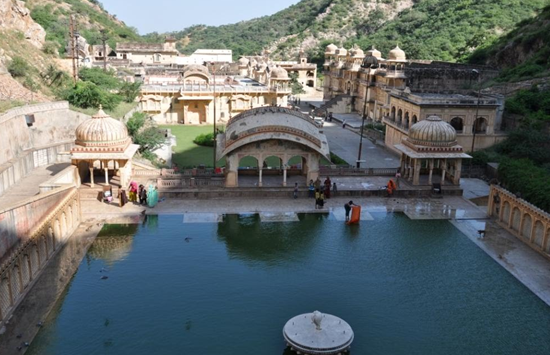
In that famous historical place of Galta, the Gaudiya vaisnava scholars were on one side, the Ramanandi scholars were on the other side and the king was in the middle as the referee. They were both very much prepared to establish their conclusions. “So where is your commentary of Vedanta sutra?” Baladev Vidyabhushan handed them hand written scrolls. He said “Who has written this?” Baladev Vidyabhushan said “Actually, Govindaji spoke it. Therefore I have entitled it Govinda Bhasya. He used my hands to write it.” They carefully scrutinizingly studied that commentary of Vedanta sutra and were amazed at the depth of the philosophy, the authority of the scriptures it was backed on, the realization, the love, the emotion in which it was written, it was unsurpassable. But still they somehow or other tried to defeat the various points, but Baladev Vidyabhushan just kept showing them different particular verses in the commentary that completely answered and refuted all of their arguments. After some time the Ramanandis were utterly silent and Jai Singh, the king said “Victory to Gaudiya vaisnavism ! They have authorized themselves as truly worthy”. And then he ordered Srimati Radharani to be brought back to the side of Sri Govindaji.
